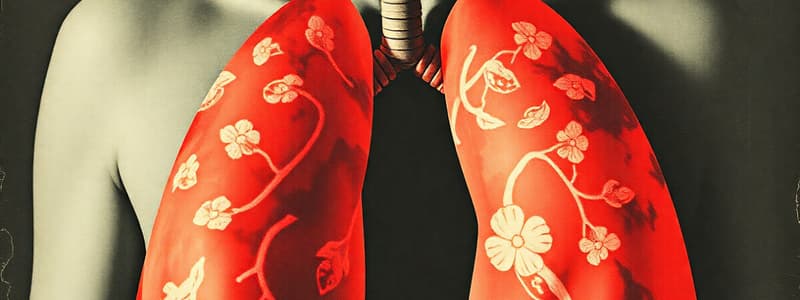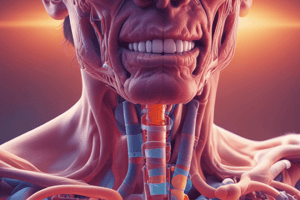Podcast
Questions and Answers
What angle should the patient be positioned at for a respiratory physical examination?
What angle should the patient be positioned at for a respiratory physical examination?
- 180 degrees (supine)
- 90 degrees (upright)
- 0 degrees (prone)
- 45 degrees (semi-recumbent) (correct)
Coldness in the hands during a respiratory examination may indicate which of the following?
Coldness in the hands during a respiratory examination may indicate which of the following?
- Normal body temperature
- Anxiety or hyperventilation
- Vasoconstriction or poor perfusion (correct)
- Vasodilation or excessive sweating
What does 'PERRL' typically assess during the eye examination?
What does 'PERRL' typically assess during the eye examination?
- Peripheral vision and retinal lesions
- Pupillary expansion response latency
- Pupils equal, round, reactive to light (correct)
- Patient's emotional response to room lighting
Bluish discoloration of the nails, indicative of peripheral cyanosis, suggests what level of reduced hemoglobin?
Bluish discoloration of the nails, indicative of peripheral cyanosis, suggests what level of reduced hemoglobin?
Besides COPD, flapping tremors can be indicative of which condition?
Besides COPD, flapping tremors can be indicative of which condition?
What underlying physiological principle is associated with pursed-lip breathing?
What underlying physiological principle is associated with pursed-lip breathing?
Miosis, characterized by pinpoint pupils, is often associated with which of the following conditions or substances?
Miosis, characterized by pinpoint pupils, is often associated with which of the following conditions or substances?
In which direction is the trachea normally slightly deviated?
In which direction is the trachea normally slightly deviated?
A patient presents with ptosis and diplopia. Which of the following conditions is most likely?
A patient presents with ptosis and diplopia. Which of the following conditions is most likely?
Understanding that Trail's sign is associated with the examination of the neck during a respiratory assessment, which of the following best elaborates its detection mechanism and clinical implications?
Understanding that Trail's sign is associated with the examination of the neck during a respiratory assessment, which of the following best elaborates its detection mechanism and clinical implications?
Which of the following clinical conditions is most likely to cause a deviation of the trachea?
Which of the following clinical conditions is most likely to cause a deviation of the trachea?
If a patient's jugular venous pressure (JVP) remains elevated even when sitting upright, this likely indicates:
If a patient's jugular venous pressure (JVP) remains elevated even when sitting upright, this likely indicates:
The angle of Louis is synonymous with which anatomical landmark on the anterior chest?
The angle of Louis is synonymous with which anatomical landmark on the anterior chest?
At the end of normal tidal volume expiration, the right dome of the diaphragm is typically located at which level anteriorly?
At the end of normal tidal volume expiration, the right dome of the diaphragm is typically located at which level anteriorly?
Which of the following best describes the characteristics of jugular venous pressure?
Which of the following best describes the characteristics of jugular venous pressure?
The oblique fissure of the left lung extends anteriorly to which rib at the midclavicular line?
The oblique fissure of the left lung extends anteriorly to which rib at the midclavicular line?
What is the anatomical landmark for the tracheal bifurcation posteriorly?
What is the anatomical landmark for the tracheal bifurcation posteriorly?
Cor Pulmonale, a cause of right heart failure, is most commonly associated with what pre-existing condition?
Cor Pulmonale, a cause of right heart failure, is most commonly associated with what pre-existing condition?
Where does the horizontal fissure of the right lung extend to anteriorly?
Where does the horizontal fissure of the right lung extend to anteriorly?
A patient presents with a shift of the trachea to the left. Which of the following conditions is least likely to be the cause for this observation, assuming all conditions are severe and unilateral?
A patient presents with a shift of the trachea to the left. Which of the following conditions is least likely to be the cause for this observation, assuming all conditions are severe and unilateral?
Flashcards
Peripheral Cyanosis
Peripheral Cyanosis
Bluish discoloration of the skin and mucous membranes, indicating low oxygen saturation.
Pursed-lip Breathing
Pursed-lip Breathing
Exhaling with pursed lips to create resistance, preventing airway collapse.
Central Cyanosis
Central Cyanosis
Bluish discoloration affecting the lips, tongue, and mucous membranes, indicating severe oxygen deficiency.
Flapping Tremor
Flapping Tremor
Signup and view all the flashcards
Ptosis
Ptosis
Signup and view all the flashcards
Diplopia
Diplopia
Signup and view all the flashcards
PERRL
PERRL
Signup and view all the flashcards
Mydriasis
Mydriasis
Signup and view all the flashcards
Miosis
Miosis
Signup and view all the flashcards
Limb Temperature (Cold)
Limb Temperature (Cold)
Signup and view all the flashcards
Tracheal Shift
Tracheal Shift
Signup and view all the flashcards
Jugular Venous Pressure (JVP)
Jugular Venous Pressure (JVP)
Signup and view all the flashcards
High JVP
High JVP
Signup and view all the flashcards
Right Heart Failure (RHF)
Right Heart Failure (RHF)
Signup and view all the flashcards
Imaginary Lines of the Thorax
Imaginary Lines of the Thorax
Signup and view all the flashcards
Anterior Thoracic Landmarks
Anterior Thoracic Landmarks
Signup and view all the flashcards
Posterior Thoracic Landmarks
Posterior Thoracic Landmarks
Signup and view all the flashcards
Oblique Fissure
Oblique Fissure
Signup and view all the flashcards
Horizontal Fissure
Horizontal Fissure
Signup and view all the flashcards
Diaphragm Position
Diaphragm Position
Signup and view all the flashcards
Study Notes
- Before conducting a respiratory physical examination, wash hands, introduce yourself, confirm patient details (name, date of birth), explain the examination, obtain consent, position the patient at a 45-degree angle, expose the chest, and ask about pain.
General Examinations
- Assess the patient's overall well-being, hydration, and nutritional status.
- Note the patient's mental status (e.g., well or unwell).
General Inspection
- Look for sputum pots, inhalers, nebulizers, or oxygen cylinders, which may indicate respiratory issues.
- Observe for cyanosis, pallor, and the use of accessory muscles.
- Identify any signs of respiratory distress or specific diseases.
Examination of the Hands
- Check temperature; coldness may indicate vasoconstriction or poor perfusion.
- Tar staining may suggest smoking, COPD, or lung cancer.
- Flapping tremors can indicate CO2 retention, COPD, or Type II respiratory failure and can be a side effect of beta agonists like salbutamol.
- Assess for clubbing and peripheral cyanosis.
- Peripheral cyanosis, a bluish discoloration of the nails, indicates oxygen saturations of ≤5 gm% of reduced hemoglobin.
- Pursed-lip breathing is a technique used in COPD to provide resistance to exhaled breath and prevent collapse.
Examination of Head and Neck
- Central cyanosis is a severe condition requiring oxygen and affects the lips, nose, ears, neck region, and tongue.
- Central cyanosis is more difficult to see in individuals with darker pigmentation; assess the palms of the hands, oral cavity, and tongue.
- Assess pupillary reflexes in neurological exams, looking for "PERRL" (pupils equal, round, reactive to light).
- Abnormal pupillary signs:
- Mydriasis (dilated and fixed pupils) may indicate brain death or drug use.
- Miosis (pinpoint pupils) may indicate opiate use or pontine hemorrhage.
- Ptosis (drooping upper lid) may be due to congenital defects or neuromuscular disease.
- Diplopia (double vision) may indicate neuromuscular disease, such as myasthenia gravis.
Neck Examination: Trachea
- Normally, the trachea is midline or slightly deviated to the right; palpate at the suprasternal notch.
- Tracheal shift can be caused by lung collapse, pneumothorax, effusion, or a tumor.
Neck Examination: JVP
- JVP (jugular venous pressure) reflects the volume and pressure of venous blood on the right side of the heart.
- In a supine position, JVP veins are full.
- At a 45º angle, the column of blood descends to a few cm above the clavicle; normal is 3-5 cm.
- High venous pressure is indicated if the column remains high even when the patient is sitting upright.
- Measure the distance the veins are distended above the sternal angle (5cm above the right atrium).
- JVP changes with breathing.
- The most common cause of elevated JVP is right heart failure (RHF), which can result from chronic left-sided heart failure or chronic hypoxemic lung disease (cor pulmonale).
- Other causes of elevated JVP include hypervolemia and obstruction of venous return to the right atrium.
- Assess the neck for lymph nodes.
Lower Limbs
- Check for lower limb pitting edema
Lung Topography: Imaginary Lines
- Anterior lines: midsternal, midclavicular, midaxillary, anterior axillary, and posterior axillary.
- Posterior lines: midspinal and midscapular.
Lung Topography: Thoracic Cage Landmarks
- Anterior landmarks: suprasternal notch, sternal angle (angle of Louis), and ribs (counted away from the sternum).
- Posterior landmarks: spinous processes of vertebrae (C7 is the most prominent spinous process at the base of the neck) and scapular borders.
Inter-lobar Fissures
- Oblique fissure: begins at the 6th rib mid-clavicular anteriorly, extends laterally and upward, crossing the 5th rib at the mid-axillary line, and continues posteriorly to T3.
- Horizontal fissure (right lung): separates the upper from the middle lobe, running from the 4th rib at the sternal border to the 5th rib at the mid-axillary line.
Landmarks
- Tracheal bifurcation: anterior- below the larynx; posterior- T4.
- Diaphragm (separates thoracic and abdominal cavities):
- At the end of normal tidal volume expiration:
- Right dome: 5th rib anteriorly, T9 posteriorly.
- Left dome: 6th rib anteriorly, T10 posteriorly.
- The resting position of the right side is higher than the left due to the liver.
- At the end of normal tidal volume expiration:
- Diaphragm position at end exhalation:
- Right dome: 5th rib anteriorly, T9 posteriorly.
- Left dome: 6th rib anteriorly, T10 posteriorly.
- The right hemi-diaphragm is higher than the left due to the liver.
Studying That Suits You
Use AI to generate personalized quizzes and flashcards to suit your learning preferences.




